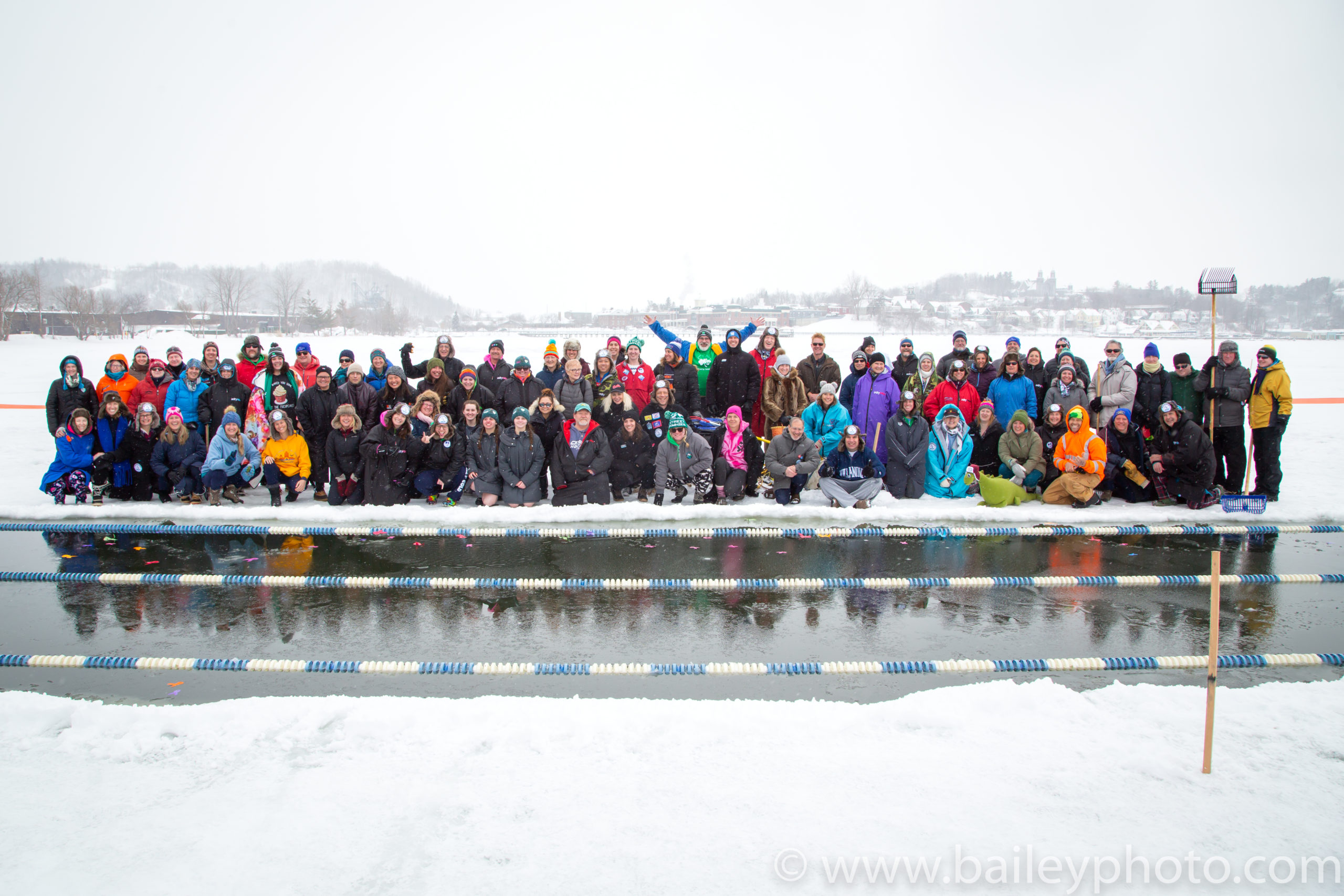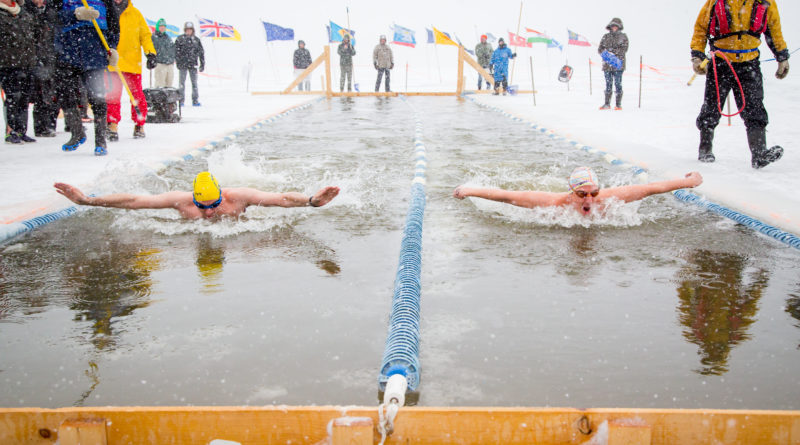Why Winter Swimming is Catching On
On New Year’s Day, a small group of women stood on the shores of Lake Willoughby and disrobed. One by one, they walked slowly into the icy, 30-degree waters at the south end of the lake for their weekly ritual.
Charlotte Brynn, a marathon swimmer and executive director of The Swimming Hole in Stowe, began swimming, her fluid freestyle strokes slicing the glassy water as she avoided the sharp-edged shards of ice.
Lynton Moore, a mental health counselor, immersed herself up to her neck, placed her palms together beneath the water and stared across the gray expanse, controlling her breathing and sitting for a minute or two, practicing the Wim Hof method. before she took a few tentative strokes.
“Each of us comes into this with a different approach,” Brynn said by phone a few days later. “I’m out there thrashing about and pushing myself to get stronger while Lynton is in a more meditative state. But we all get this huge benefit from it and when we get out, there’s this rush of endorphins,” she said. “Plus, there’s just great camaraderie. We all know it’s going to be really hard at first, but it will feel great later. It’s just a feeling of pure joy.”
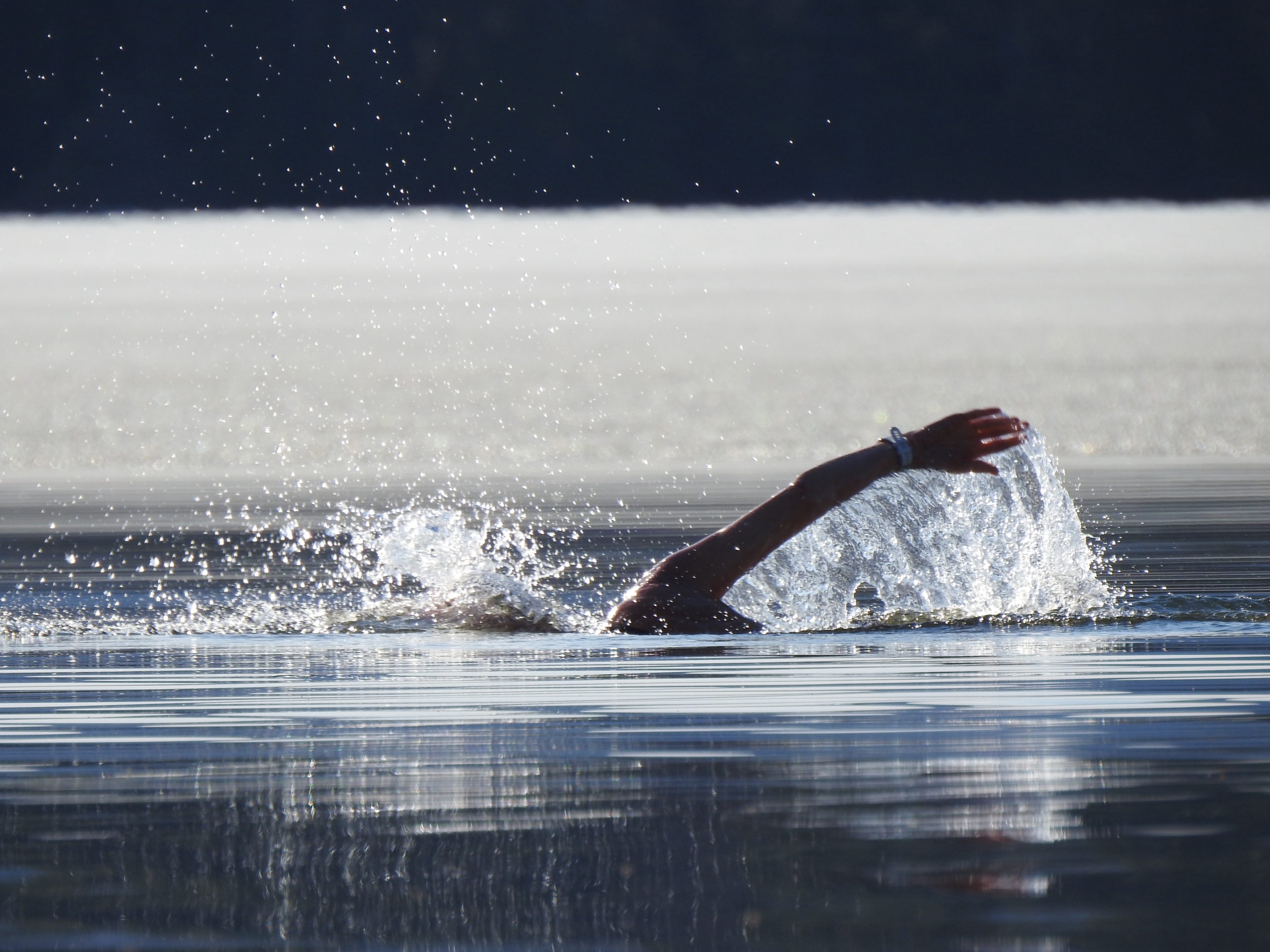
For Brynn, 55, one of the goals of cold-water swimming is to help her train for her fourth attempt at an English Channel crossing, one she hopes to do this summer. “Swimming in really cold water helps you build endurance,” says Brynn, who grew up in New Zealand. For years, she would swim at Green River or Waterbury Reservoir as late in the season as the ice would allow. “If you can do that, you can do anything, right?” she says.
In April, 2014, she completed her first sanctioned “ice mile,” a 1.19-mile swim in Lake Champlain in water under 4.8ºC (40.8ºF). She swam it in 40:48. That same year she was nominated for World Open Water Swimming Woman of the Year.
For Moore, 54, the weekly cold-water immersion is part of a practice: “I don’t like the word ‘spiritual’ but it’s part of a practice that includes yoga and breath work. Going into the cold water feels like a purification. It feels like connecting with the divine.”
Both Brynn and Moore recently moved to Newport, VT —Brynn from Stowe and Moore from Telluride, Colo. “I saw this other woman coming out of the lake on one freezing day and thought, wow – there’s another one,” says Moore who didn’t know of Brynn’s swimming background at the time. Four or five other women—ages mid-twenties to mid-seventies—soon joined what became a weekly swim. “We started in Memphremagog and we’ll just keep moving around each week looking for lakes that are not frozen,” Moore says.
In February, Brynn, Moore, and the others will drop into a 25-meter pool cut into the ice on Lake Memphremagog in the 8th running of the Lake Memprhemagog Winter Swimming Festival. Some may do just one event. Others are signed up to race as much as 200 meters. “We have a team, the Shark Bait Sheilas – Charlotte, who is a Kiwi, came up with the “Sheila” term and I’ve already ordered shark hats,” says Moore with a giggle.
Winter Swimming’s Pied Piper
Newport’s Shark Bait Sheilas. The Fair Haven Jailbirds. The Muffin Tops of Middlebury. The Red Hot Chili Dippers of Burlington. Around Vermont, more and more swimmers (and dippers) are heading into the open water as late as they can in the season – or year-round, when the ice isn’t a factor. “I see a growing trend says Phil White who puts on the Lake Memphremagog Winter Swim Week, each February.
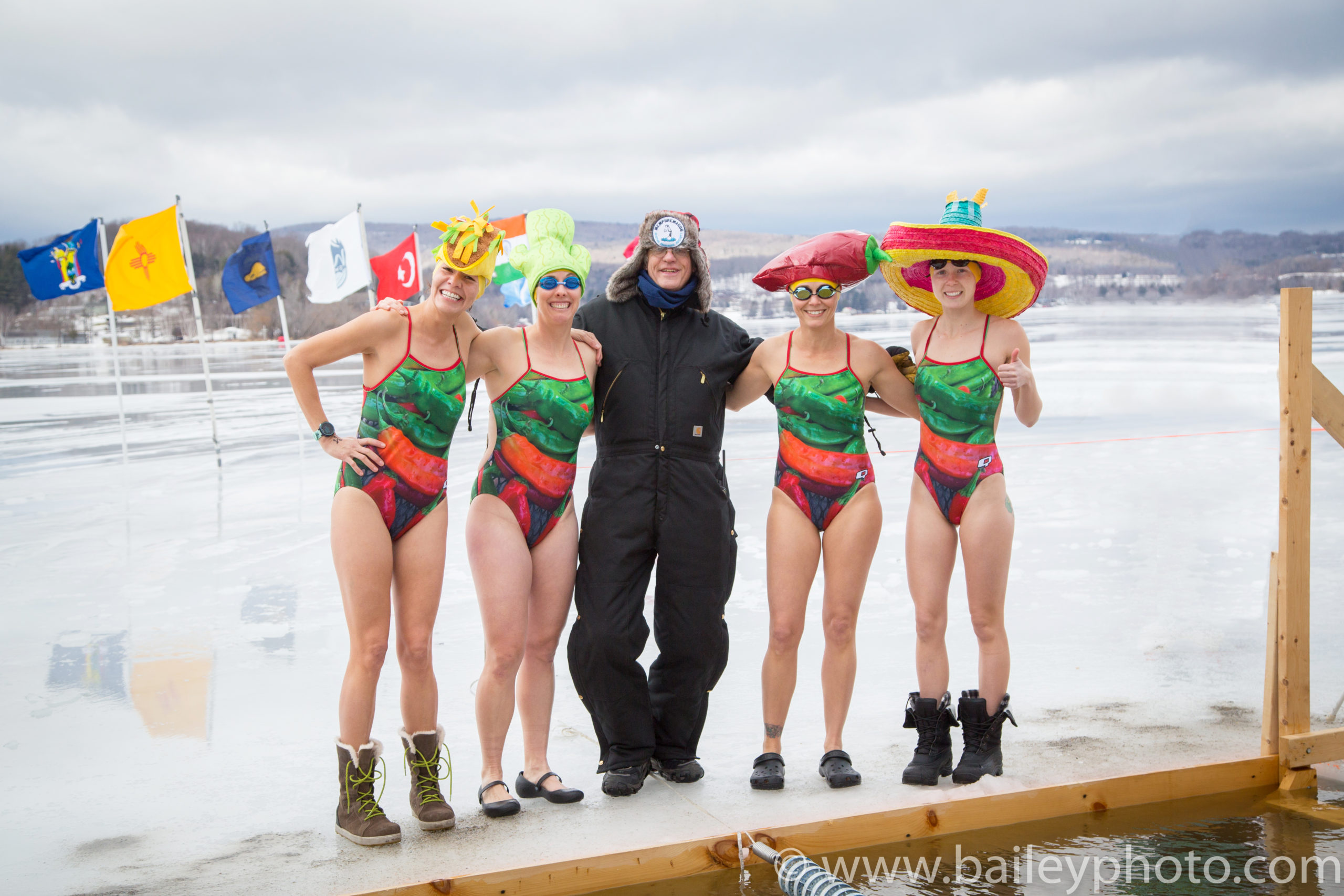
White, 73, sporting a long white beard that makes him a dead ringer for St. Nick, is the pied piper of open water swimming in Vermont. As a former member of Newport’s Chamber of Commerce and a director of the IROC fitness center, White launched a series of athletic events that became a business: Kingdom Games. There was The Moose bike ride through the NEK; and races such as the Dandelion Run and Fly to Pie. And then there were his swim events, which grew to include open water swims on Lake Memprhemagog of up to 25 miles as well as his summer Kingdom Swim Week where swimmers, accompanied by paddlers, swim all the lakes in the NEK.
But the most improbably successful event he initiated was the Lake Memphremagog Winter Swim Festival, an annual late February swim race that takes place in a two-lane, 25-meter ‘pool’ that’s cut out of the ice in Lake Memphremagog
“It started as a bad joke, took a wrong turn, and it became an adventure,” White likes to say, with a chuckle, by way of explanation. “In 2014 I was watching these guys use this huge saw to cut blocks out of the lake to use for an ice maze or igloo or something,” he says. “So I took a picture of it, posted it on Facebook with a caption as a joke, saying ‘Anyone want to come swim?’”
Remarkably, White got a response. Before long, he had connected with the new U.S. Winter Swimming Association. “They had just formed but didn’t have a venue. We had a venue but no idea how to put on an event like this,” he says.
The first year was a struggle. The US Winter Swimming Association contingent didn’t arrive until the day of the event. The ice was so thick White had to find extra long chain saws. The morning of the event it was 10 degrees, and the surface had frozen again overnight. He had to recruit locals to chop the surface with axes. Still, 40 or so swimmers showed up, coming from as far as Europe and the Eastern Bloc countries where winter swimming is a serious sport.
The next year, White resolved to make the event fun for amateurs as well. The first event would be a 25-meter “hat race” —what is now the most hotly contested event of all. “The idea was for people to make these crazy hats and if they wore the hats and did the breaststroke, they wouldn’t dunk their heads in the water which makes it much safer,” he says. He started an awards pajama party with dinner following at the East Side Restaurant. “If you show up in your pajamas, you get a free shot of Barr Hill Vodka,” he explains. “After a cold-water swim so many endorphins are released it’s always a great party.” Awards took the form of beef jerky or maple syrup.
Even the safety protocols are infused with humor. Volunteers who walk the swimmers to and from the changing house (to ensure they were not hypothermic or slipped on the ice), are “Escorts.” Others who disrobe the swimmers and helped them dress again at the other end of the pool are “Strippers.” And during each lap, volunteers walk alongside the swimmers with a hook, in case anyone needs to be pulled out. They are, of course, “Hookers.”
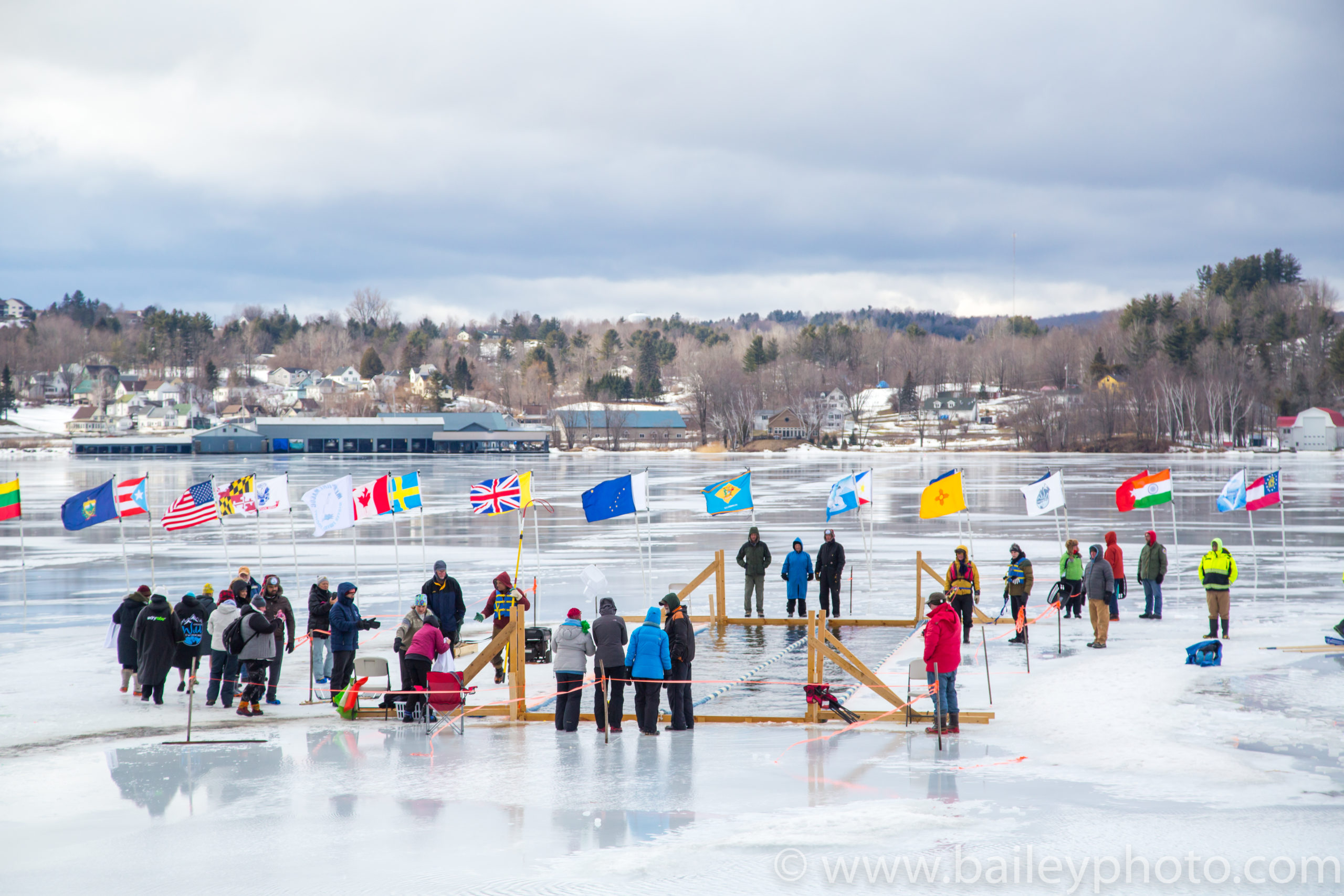
Brynn and others helped him organize the event and White reached out to other international swimmers with ties to Vermont. The second year, there were around 30 paying participants. By 2020 there were 90 and for 2022, White had to limit the field to 135 and it has sold out. Ages range from Derby’s 14-year-old marathon swimmer Margaret Rivard to Anne Coen, 79, of Canton, Ohio.
The Lows and Highs of Cold Water
White’s Memprhemagog Winter Swimming Festival may be the only one of its kind in North America, but it is part of a growing international league. “Ice Swimming,” is a term first coined in 2009 by the International Ice Swimming Association which was founded the same year. The sport is defined as “swimming in water temperature of 5.0C / 41.0F unassisted, with a silicon cap, pair of goggles and standard swimming costume,” in other words, no wetsuits. IISA focuses on more extreme events such as “ice miles,” while the International Winter Swimming Association (IWSA) puts on shorter events, that usually follow typical swim race formats: 25-, 50-, or 100-meter lengths, relays and a choice of strokes.
Two Charlotte Vt residents, Julie Postlewaite, 49, and Susan Blood, 54, —went on to compete in the IWSA 2020 Winter Swimming World Championships in Bled, Slovenia after having attended the Lake Memphremagog Winter Swim. Postlewaite hopes to swim in the World Championships in Russia in March of 2022 and has been training by swimming in Lake Champlain every day, year-round.“That January day when it was -10 degrees and the schools were closed? We went in. It felt good,” she says
But as any experienced ice swimmer will warn, cold-water swimming is something that takes training. “It’s not something I share with my students,” says Karyn Stannard, an assistant middle school principal who lives in Fair Haven, Vt. and swims until her nearby lakes freeze over. “It can be dangerous if you don’t do it correctly. I won’t swim with anyone who hasn’t been practicing this,” says Stannard who usually swims in Sunset Lake in Benson or Lake Bomoseeen with her husband and brother-in-laws. When Stannard first started swimming later in the season she used a wetsuit and gloves. “But after I started reading about ice swimming, I started shedding gear. I now swim with just a bathing suit.” The reason: it takes a while for a wetsuit to warm up and it’s often hard to get off when you get out.
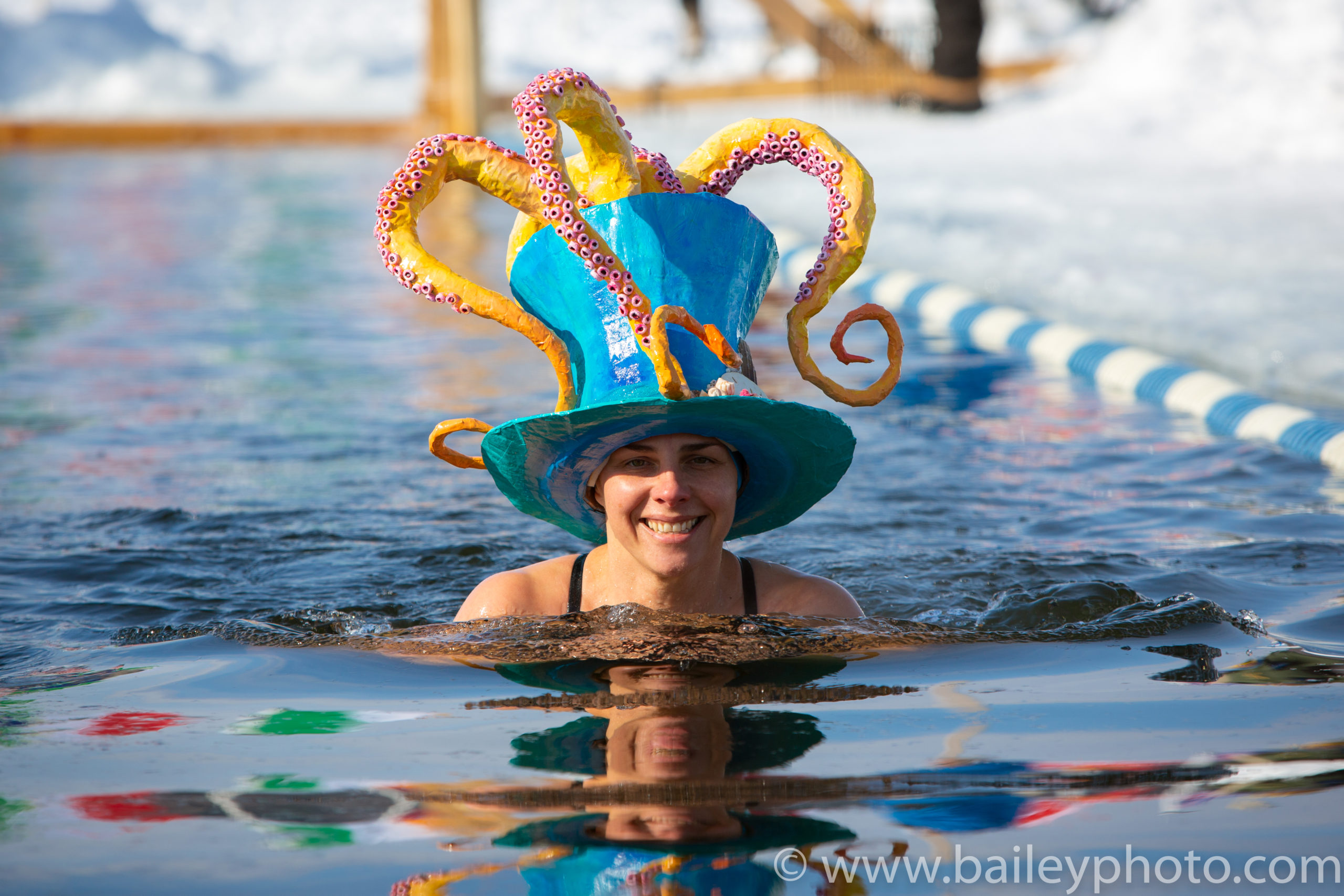
“Ice swimming is pretty exciting—and the first few times it is a little frightening, too” says Brynn. “But once I got in and relaxed and focused on my breathing, it was just a really incredible experience. It’s very calming. And it’s beautiful out there. A lot of us are deterred from trying things because we think we can’t. And I think the thing that struck me is this is actually achievable.”
Brynn recommends taking it slowly and working your way up to colder and colder temperatures and staying in longer and longer. Being able to warm up in a car or house after is important and expect your body to stay cold for some time after a swim, or experience an “after drop,” in temperature. Brynn also notes that the cold water saps your energy: “I swam 400 meters in a pool in November and it took me 5 minutes, 41 seconds. A few days later I swam just as hard in 39-degree water and it took me nearly 7 minutes.”
She cautions people to read and learn before trying this. “When you come across something that your mind and your body aren’t used to, the initial response is fear, anxiety and discomfort and you have short, shallow breaths,” Brynn says. However, she adds “after repeated exposures to the cold water in a controlled environment, and by focusing on relaxing, with long, slow inhales and exhales, you can reduce that incidence of shock.”
Nearly every ice swimmer will tell you that focusing on your breath is critical. “You really have to train your body and breath,” says Moore who has been practicing the Wim Hof Method and teaches it to some of her clients. Before her swims, she does 30 to 40 minutes of rigorous yoga to warm up her core and 30 rounds of deep breaths, followed by a long inhale and exhale, repeated three times. “By then my cardiovascular system is ready and after two minutes the water feels like a warm comforter. I don’t feel the cold anymore.”
For Moore, the practice has been a healing process she recommends to clients as well. “I used to have a fair amount of PTSD. I don’t seem to have those symptoms anymore,” she says. “A lot of mental health issues are caused by inflammation and the cold water helps reduce that. And it produces endorphins and all these feel-good hormones. Plus, you’re not out there doing it alone so when you come out of the water there’s this sense of belonging and feeling part of a community,” she says.
“You have so much energy. All your filters are down. You just get to be your wild self. It’s really rejuvenating for anyone who is going through any kind of suffering because if you can do this, you know you can get through it.”
